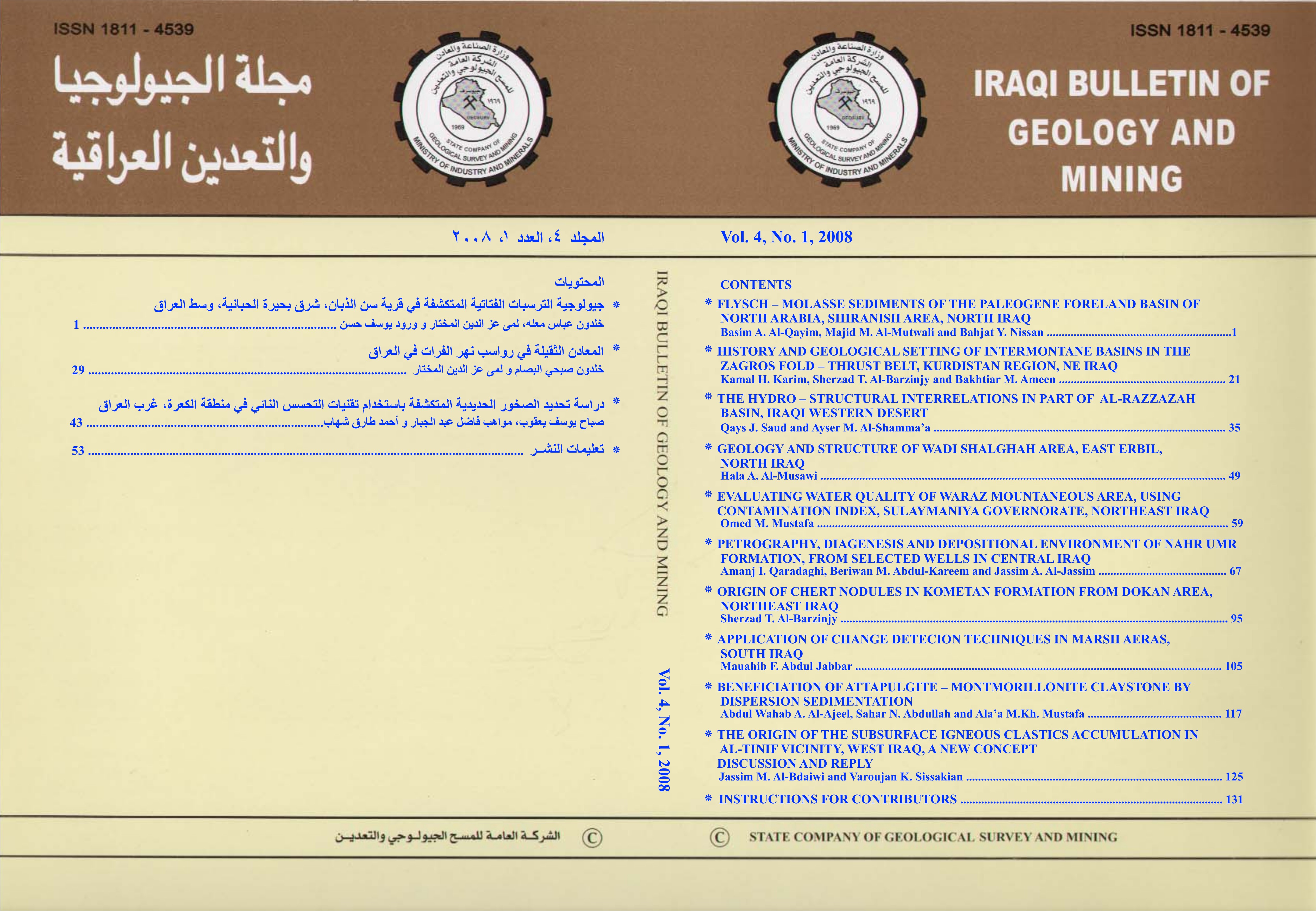Abstract
The Paleogene clastic strata of northern part of Iraq are represented by the Kolosh Formation (Paleocene – Early Eocene) and the Gercus Formation (Middle – Late Eocene). Detailed investigations of these strata at Shiranish area of north Iraq including stratigraphic association, lithofacies type, petrographic investigation, and mineralogical analysis of heavies and clay fractions disclose the geological aspects and the nature of the Paleogene Foreland Basin, which is developed along the north – northeastern margin of the Arabian Plate.
Analysis of lithofacies association of the Kolosh sediments shows that it represents a distal turbidite facies of an unattached submarine fan complex that is developed far from feeding channel systems. The Gercus lithofacies is characterized by predominant continental section with a possibility of shallow marine influence near the bottom of the section.
The petrographic analysis of sandstones from both units shows the predominancy of lith-arenite type with significant occurrence of feldspar, igneous and metamorphic rock fragments in Gercus samples. Petrofacies analyses of these sandstones show that the Kolosh sandstones were derived from “Recycled Orogen” province, and developed as a part of the foreland system. The Gercus sandstones show similar tendency with clear effect of arc-volcanicity. Heavy and clay minerals analysis show assemblages, which support similar interpretation.
The sediments of Kolosh and Gercus formations are believed to represent the flysch – molasse facies of the distal part of the Paleogene Foreland Basin, which is developed in North Iraq as result of the advancing Bitlis Nappes onto the northern Arabian margin.
Analysis of lithofacies association of the Kolosh sediments shows that it represents a distal turbidite facies of an unattached submarine fan complex that is developed far from feeding channel systems. The Gercus lithofacies is characterized by predominant continental section with a possibility of shallow marine influence near the bottom of the section.
The petrographic analysis of sandstones from both units shows the predominancy of lith-arenite type with significant occurrence of feldspar, igneous and metamorphic rock fragments in Gercus samples. Petrofacies analyses of these sandstones show that the Kolosh sandstones were derived from “Recycled Orogen” province, and developed as a part of the foreland system. The Gercus sandstones show similar tendency with clear effect of arc-volcanicity. Heavy and clay minerals analysis show assemblages, which support similar interpretation.
The sediments of Kolosh and Gercus formations are believed to represent the flysch – molasse facies of the distal part of the Paleogene Foreland Basin, which is developed in North Iraq as result of the advancing Bitlis Nappes onto the northern Arabian margin.
Abstract
تتمثل طبقات الباليوجين الفتاتية في الجزء الشمالي من العراق برواسب تكوين الكولوش (الباليوسين - الإيوسين المبكر) وتكوين الجركس (الإيوسين الأوسط – الإيوسين المتأخر). لقد بينت الدراسة التفصيلية لهذه الرواسب من حيث العلاقات الطبقية، أنواع السحنات الرسوبية والتحليل البتروغرافي والمعدني في منطقة شيرانش، شمال العراق، خصائص وطبيعة الحوض الرسوبي الفورلاندي الذي نشأ عند الحافة الشمالية – الشمالية الشرقية للصفيحة العربية. أوضح التحليل السحني لرواسب تكوين الكولوش بأنها تمثل سحنات الرواسب العكرة البعيدة لمعقد مروحة بحرية منفصلة عن قناة التغذية الرئيسية. تتصف سحنات تكوين الكولوش بمقطع من الرواسب القارية مع احتمال وجود تأثيرات بحرية في الأسفل.
اظهر التحليل البتروغرافي للصخور الرملية لكلا التكوينين بأنها من نوع الرمال الفتاتية مع غلبة وجود الفلدسبار والفتات النارية والمتحولة الأصل في صخور تكوين الجركس. أظهر التحليل الصخاري السحني للصخور الرملية ان أصل رواسب الكولوش من إقليم \\\\"اوروجيني معاد\\\\" تجمعت ضمن حوض الفورلاند. أما رواسب الجركس فقد أظهرت أصول متشابهة مع تأثير واضح لبركانيات قوسية (Arc). كما أظهر تحليل المعادن الثقيلة لهذه الرواسب استنتاجات متشابهة.
إجمالا تمثل رواسب تكويني الكولوش والجركس رواسب الفليش والمولاس لحوض الفورلاند الباليوجيني الذي تطور في شمال العراق نتيجة تقدم كتل معقد بيتليس على حافة الصفيحة العربية.
اظهر التحليل البتروغرافي للصخور الرملية لكلا التكوينين بأنها من نوع الرمال الفتاتية مع غلبة وجود الفلدسبار والفتات النارية والمتحولة الأصل في صخور تكوين الجركس. أظهر التحليل الصخاري السحني للصخور الرملية ان أصل رواسب الكولوش من إقليم \\\\"اوروجيني معاد\\\\" تجمعت ضمن حوض الفورلاند. أما رواسب الجركس فقد أظهرت أصول متشابهة مع تأثير واضح لبركانيات قوسية (Arc). كما أظهر تحليل المعادن الثقيلة لهذه الرواسب استنتاجات متشابهة.
إجمالا تمثل رواسب تكويني الكولوش والجركس رواسب الفليش والمولاس لحوض الفورلاند الباليوجيني الذي تطور في شمال العراق نتيجة تقدم كتل معقد بيتليس على حافة الصفيحة العربية.
